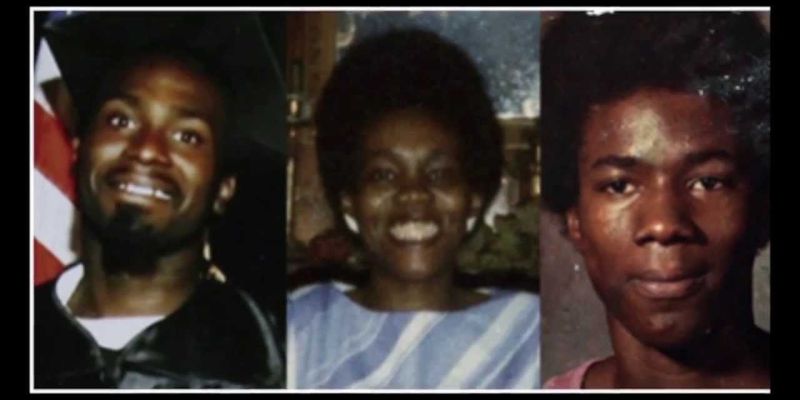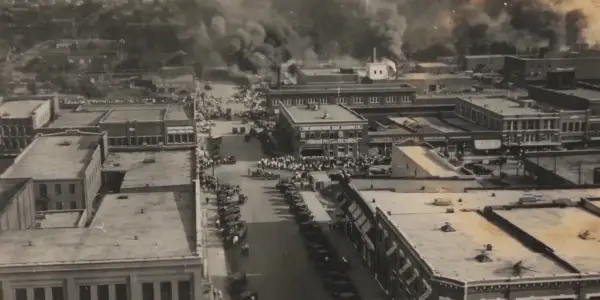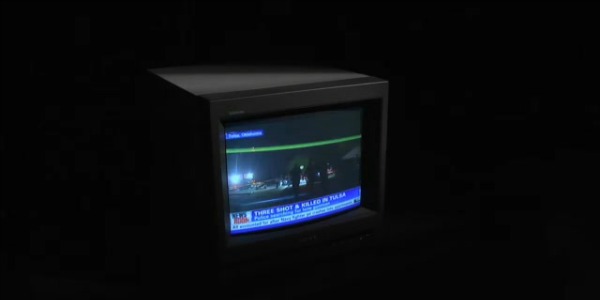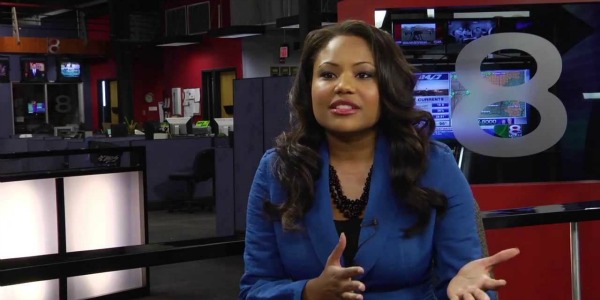HATE CRIMES IN THE HEARTLAND: The Need For A Revisionist History

I got started watching avant-garde film at Oklahoma State University…
Rachel Lyon’s wide-eyed documentary Hate Crimes in the Heartland revisits the largely ignored history of racial violence in Tulsa, Oklahoma. In the wake of a racially motivated shooting spree on Good Friday in 2012, Lyon interviews survivors, leaders, historians, and residents to discuss the city’s racially divided legacy and the effects of the “Tulsa Race Riot,” a misnomer for the day long, Ku Klux Klan-led decimation of Black Wall Street’s infrastructure.
Interviewees discuss the contemporary effects of the small-scale genocidal effort in 1921 and media coverage of the Good Friday shootings in 2012. The patchwork narrative tells two separate but geographically and culturally related stories in the hopes that the former will shed light on the latter. While the movie is revelatory and demonstrates an important gap in popular historical accounts, the interview-as-narrative is disruptive to any unified historical document.
Forgetting History
In the 1910’s, Tulsa, Oklahoma was a destination for African-Americans fleeing the oppression of the Deep South. Tulsa was, for a brief moment, a city with one of the most prosperous African-American communities anywhere in the country. The Greenwood neighborhood, known then as Black Wall Street, was home to hundreds of black-owned business and an economy that was semi-autonomous from white-owned institutions. Following false allegations of an assault by a black man on a white woman, the white community of Tulsa armed itself against the black community and systematically burned down businesses and murdered community leaders. The community never recovered, and the event has been widely omitted from history textbooks.

Flash forward 90 years and Tulsa’s racial division is a case study in modern day segregation. Hate Crimes in the Heartland smartly points out that one of the unique features of the Good Friday shootings was the local and national media’s willingness to label the shootings a hate crime almost immediately. This conclusion was made quickly because one of the shooters posted online his intention to commit violence against African Americans. Here, Hate Crimes in the Heartland reveals the way that social media changed the social definitions of hate crimes.
Contemporary media were able to label the violence as a hate crime, generate outcry, and mobilize a massive police response. While this seems an obvious improvement to the media coverage of the violence in 1921, when newspapers reported conflicting information and generally tended to blame the Black community for the violence, Hate Crimes in the Heartland should remind us to be wary of the contemporary amnesia that has already forgotten the Good Friday shootings among the flood of now commonplace mass shootings.
Styles That Matter
Formally, Hate Crimes in the Heartland is a barrage of talking-head interviews and footage of archival news stories frequently framed in box television sets. This technique is not uncommon, and here it is mostly effective even if the pace is rushed. In other words, it is shot like an Errol Morris documentary without any of the contemplative patience of The Thin Blue Line or Standard Operating Procedure.

By framing the televisual device within the movie, news coverage is appropriately contextualized as a dated, historical object that, much like the box TV, becomes obsolete and forgotten with increasing rapidity. Hate Crimes in the Heartland archives the news coverage of the Good Friday shootings as it uses the coverage to narrate the events for an audience unfamiliar with the shooting; the movie operates on these two levels to effectively maintain critical distance to the media coverage.
Though the information presented is riveting, the movie relies on a broad range of interviewees whose testimony are often chaotically juxtaposed with various degrees of authority, objectivity, and bias. In one sequence, Derek Cowan, a resident of Tulsa, says, “Tulsa is still divided.” Immediately after this shot, Lyon cuts to the typical medium-close up of handle-bar mustachioed Douglas Embry, who says, “I think our race relations are fairly good; if I were black I wouldn’t feel that way.”

These two seemingly random residents, the first black and the second white, give the clear impression that the city still suffers racial division. By bouncing from one subject to the next– from 1921 to Good Friday of 2012 and other events like the shooting of Trayvon Martin– Hate Crimes in the Heartland shapes a conversation about racial violence more than it settles on hashing out any one topic.
Conclusion
Rachel Lyon‘s movie is open-ended – weaving together testimonials of witnesses, victims, experts, and residents, the narrative is never presented as an authoritative telling but rather as an archival project to document an existing but repressed conversation about racial violence. The movie attempts to connect Tulsa’s racial violence to the increasingly visible racial violence across the country, which distracts from the focus of the movie and the already thinly spread story-line. Instead of telling a detailed, exhaustive account of the violence in 1921, Hate Crimes in the Heartland skirts and teases all but the basic outline of this story in its effort to connect the event to the Good Friday shootings.
It seems more productive to think of historical archiving as the movie’s productive function, and the excavation of a historically suppressed archive is an important project that deserves wider visibility. In its marketing campaign throughout 2015 and limited release, the movie seems destined for pedagogical purposes and small, University audiences, where its open-ended structure will give students plenty of questions left to discuss. The first question I had to Google after watching the movie: “Did the U.S. government drop bombs from planes on Tulsa, Oklahoma in 1921?”
Full disclosure: I am a native Okie and have lived most of my life within 50 miles of Tulsa, but I didn’t understand the white supremacist motivations or the brutality of the Tulsa Race Riots.
Had you ever heard of the Tulsa Race Riot? Do you think the Hate Crimes in the Heartland does a good job of telling the story of Tulsa’s violent history?
Hate Crimes in the Heartland is getting its digital and DVD release on January 12, 2016.
Does content like this matter to you?
Become a Member and support film journalism. Unlock access to all of Film Inquiry`s great articles. Join a community of like-minded readers who are passionate about cinema - get access to our private members Network, give back to independent filmmakers, and more.
I got started watching avant-garde film at Oklahoma State University at an event called Exciterbulb. Through this I have been fortunate to view a decent number of rare avant-garde films, and accounting for these technological miracles is my main intellectual curiosity in life. I view and review movies of all sorts, and in general I never shy away from a pointless debate.













